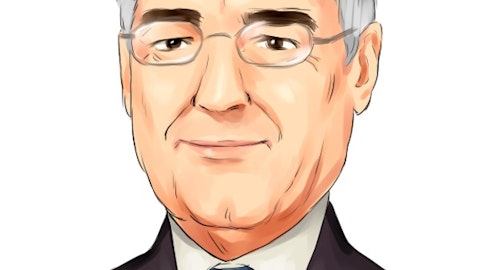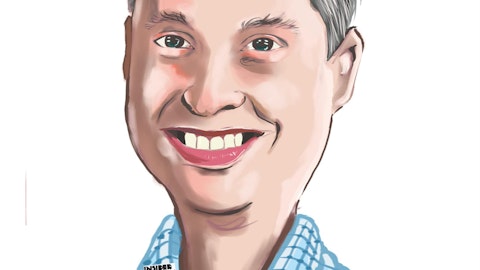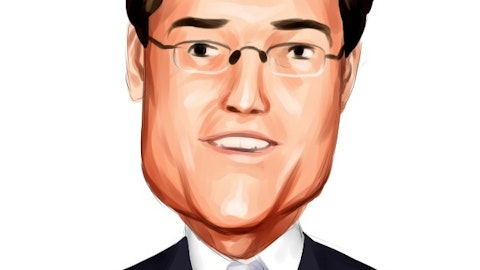Operator: Our next question comes from the line of Stefanos Crist with CJS Securities. Please proceed with your question.
Stefanos Crist: Hi. Thanks for taking my questions. First just on inventory just the timing of converting that. Is that expected to happen in the next quarter or is that maybe more of a starting in the back half of the year?
Niko Lahanas: No. The way our business is, you see the working cap build kind of through the tail end of Q1 and then it peaks out sort of mid-Q2 and then starts to come down. A couple comments in inventory. In absolute dollars, it was obviously up about $180 million. Couple things I want to point out, we mentioned are focused on cost and cash. If you look at the quarter itself the inventories were actually down. We €“ a year ago in Q1, we came up about $160 million. And if you flip through the cash flow, you’ll see that. And then this quarter, this last quarter, we are only up $85 million. And then that’s reflected in cash used from operations, which was only $63 million versus $92 million a year ago. So you can kind of see the early sort of fruits of our labor. We were very serious when we said we were going to focus on cost and cash, and I think we’re starting to see the early stages of that with a lot more to come as the year plays out.
Stefanos Crist: That’s great color. Thank you. And then this thing about acquisitions, just talk about what you’re seeing in the M&A pipeline and maybe deal flow versus what you saw 12 months ago.
Niko Lahanas: Yes. I mean, we’ve sort of said this on a couple of past calls. The deal flow has definitely slowed down. I think as we look at the volatility in the public markets, the private market tends to follow that. So, clearly deal flow has slowed, the pipeline is not quite what it was 12, 18 months ago. But we’re still out there. And we still have a number of deals that are in play and discussions that are going on. So it’s not going to deter us. For us, it’s all about finding the right fit, the right company, management team and the right margin profile for us. So we’re still going full speed ahead.
Stefanos Crist: Great. Thank you.
Operator: Our next question comes from the line of Brad Thomas with KeyBanc Capital Markets. Please proceed with your question.
Taylor Zick: All right. This is Taylor Zick on for Brad Thomas. Thanks for taking my question. I’m curious on some of the factors. If you touch on some of the factors that have been impacting the business from an inflation standpoint, and kind of how you’re thinking about those for the rest of the year. And then additionally, if you can kind of just talk about maybe what your customers were saying in terms of pricing as you kind of continue to push these prices through? Thanks.
Niko Lahanas: Yes, I mean, as far as inflation goes, last year was unprecedented. We’re still seeing some continued inflation into 2023, but it’s certainly moderating in our opinion. Everyone has seen labor has sort of flattened out. Delivery certainly has moderated, especially ocean freight. Fortunately we can’t take full advantage of a lot of like the ocean freight, because we do have heavy inventory, so we’re not bringing in as much product right now. We need to sell through what we’ve got. But I would say overall the trend, there’s a moderation going on. That said, we’re still at historically very, very high levels. So, we’re still combating that.
Tim Cofer: Yes. And the build on Niko’s comments, I think you said it well, Taylor, look, we’re still in an inflationary environment and our total cost envelope is going up year-over-year. It is unfavorable. And you ask for a little bit, some of the details, I mean, certain of our commodities around grains, grass inputs, wheat and potato starch for dog treats, et cetera. These are still year-over-year and unfavorable cost input into our total envelope. And so and that’s why we’re pricing as we price, because we have that pressure and we are seeking to do our best to maintain if not expand margin. But the order of magnitude of the increase is definitely diminished 2023 versus 2022 compared to 2022 versus 2021, as Niko said.
Taylor Zick: Got it. Thank you. And then if I could just squeeze one last one. How did that pet to stocking kind of turn out this quarter relative to what you had expected for the last quarter?
Niko Lahanas: Yes for Q1, as Tim mentioned, our POS was 6% and our shipments weren’t close to that, right? So, you can see customers continue to tighten their inventories. Our expectation is that we’ll continue to impact us in Q2, and then it will normalize mid-year.
Taylor Zick: Great. Thank you.
Operator: Our next question comes from the line of Andrea Teixeira with JPMorgan. Please proceed with your question.
Andrea Teixeira: Thank you, and good afternoon. I have two clarifications please. On the exit of the private label contract. I understand that it started last quarter, so you’re through the first half of it. So I want to just clarify that, and then you’re going to lap in the fourth quarter. So what is the magnitude of that impact? And on the EPS guide, of course, I understand this is like a small quarter, but can you talk about like cadence if we should expect basically inflection in the second quarter and how to think about it? And lastly, if you can talk about market share trends? Thank you.
Tim Cofer: I’ll do that one. All right. Well have John Hanson take the pet bedding, Niko will take EPS, I’ll take market share. John?
John Hanson: Yeah. So on pet bedding; we have a meaningful private label pet bed business. In Q1 of 2022, we proactively rationalized skews. And then in the back half, we decided to exit some low margin product lines to improve margins profitability. We started laughing that in the back half of fiscal 2023. We’ll see that throughout 2023. In this business and other businesses, we’re going to continue to critically assess our cost competitiveness to improve margin and improve profitability. So it’ll be a €“ it’s an ongoing effort from us and to a degree, normal part of our business.
Niko Lahanas: And just speaking EPS, Andrea, so next quarter Q2, we’re still expecting EPS to come in a little bit lower than a year ago. As I mentioned in my prepared remarks, it’s really a back half story for us here as more pricing kicks in. We see a little bit more normalization in terms of retail inventories throughout the year. And then, we’re assuming a more normal sort of weather pattern as we go through that. And then all along we’re going to be controlling costs and cash. So it’s going to be a Q3, Q4 story as we head to the $2.60 to $2.80 guide.





